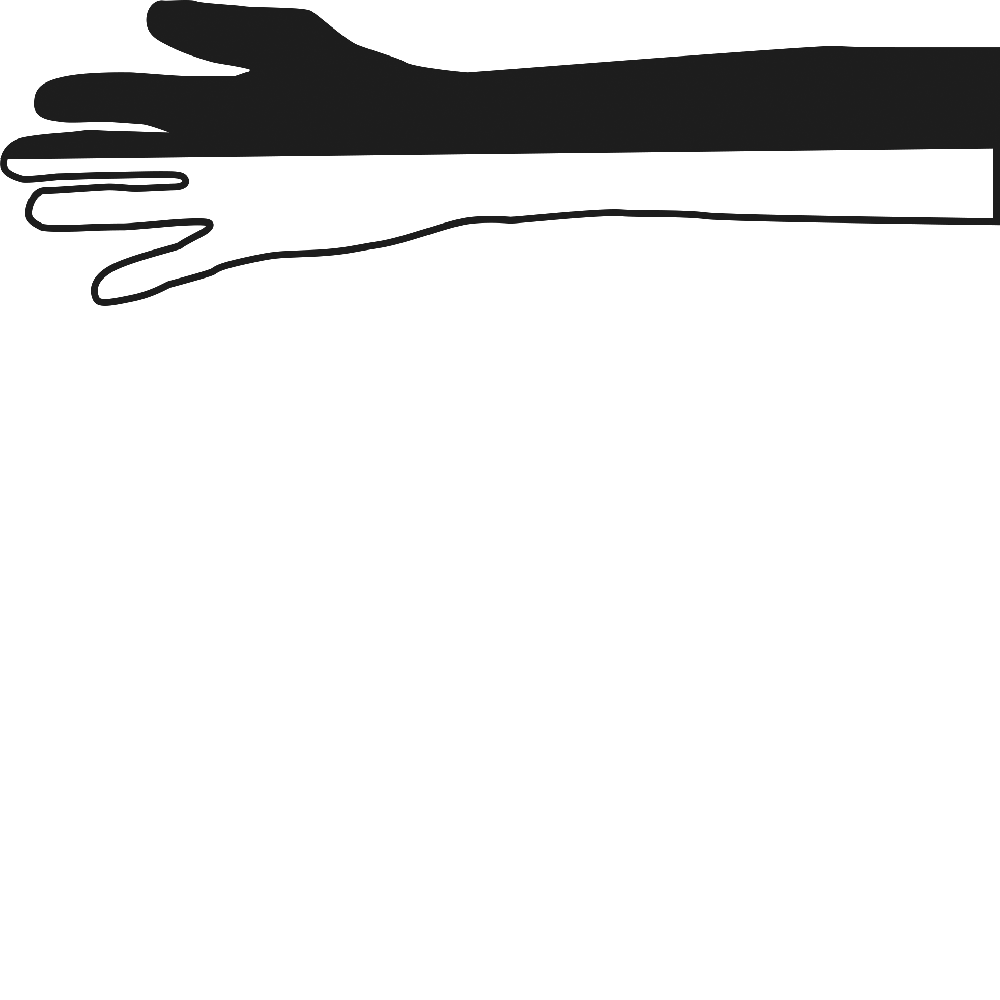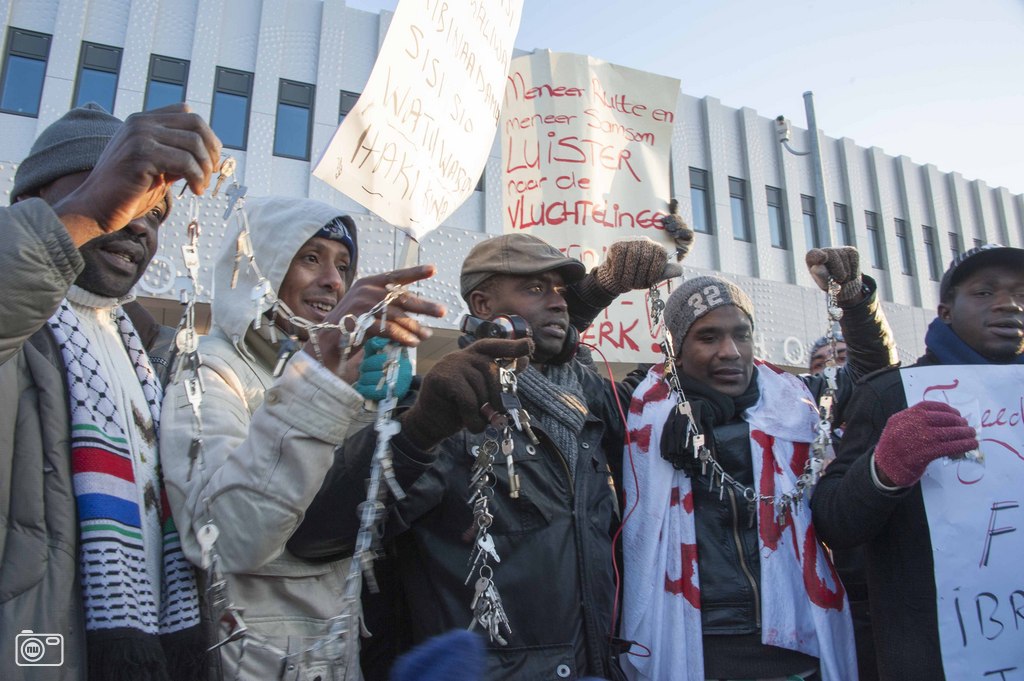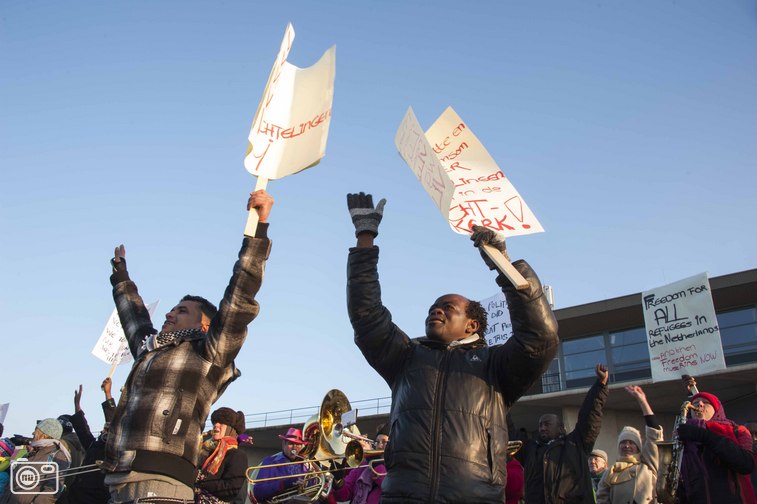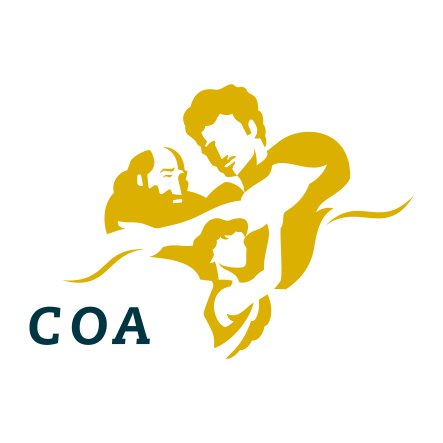This is a picture of a few of the people who really politicize me. Late December 2012, I decided to have a 30-day birthday celebration. And part of it was making patties, vegetarian patties, for the people who lived — who squatted Vluchtkerk. At the time, it was a big church, it was empty and was guarded by people who the Dutch government calls “illegals.” So, they were people who were out of a procedure and had no place to go, because in the Netherlands, while you’re not in a procedure, you have no right to housing. You have no right to care, so you’re basically left to fend for yourself, on the streets. They squatted a building, and when you walked in there — I thought I have seen quite a few things, but that really shook me to my core, to see how people had to live in that specific environment. Also because the church was just squatted, so it just kind of looked like an empty building with a lot of people who were just figuring out what to do at that specific moment. And for me, that was really a politicizing moment to see that.
I think we get kind of stuck on the idea of citizenship, and that we deserve something based on the fact that we either were born here, or we live here right now, but there are many people who don’t have the comfort of what we consider policies. Who are kind of left between all the holes, because they don’t have — according to the government, they don’t have rights to the basic needs. And these are some of the men who really politicized me, and you see — in the back, you see the sign that says “Meneer Rutte en Meneer Samsom, luister naar de vluchtelingen in de Vluchtkerk” which means, “Mister Rutte and Mister Samsom, listen to the people inside of the building,” which is called De Vluchtkerk.
But now, you see that the narrative is shifting. Now, often when you see people talk about them, they get talked about. And that was kind of the moment where it was still — it was sort of a raw process. They could speak for themselves more often. And mainly that had to do, I think, because two of the spokespeople from the group, they spoke Dutch. But the moment somebody doesn’t speak Dutch, they are looking for somebody who could speak for you, because that’s the moment when people forget to speak English, and you need help to get your message across.
- Invitation to think (more) about:
- 1. Visualization of narratives of forced migration through “unconnected” music, film, literature and photographs
- 2. Language as a tool to socially and politically divide diasporic communities
- 3. Futurism
- 4. Body modification and/or mutilation as a form of political resistance
So, while reading Ayesha Hameed’s text, the amazing organizers Ellen and Karisa said, “well, you would really like the text.” I did, and also not so much. But what I did like about it is her invitation to think more about the visualization of narratives of forced migration, through unconnected music, film, literature, and photographs. And when I say, “unconnected,” I mean something that’s not directly linked, and doesn’t have the label of, “forced migration, refugee, illegal.” But I believe in the codes of art. So you’re gonna have a song that’s not really literally about the subject you’re talking about, but it is connected to what you would like to point out.
Second what I like about her text is the language. She really carefully — and I will get into this later. She carefully chose the word, “illegalized migrants,” which I think is a better way of describing the people who I’m talking about, because it shifts the responsibility from the person you would like to call illegal, to the government that has dubbed them illegal. And I’ll get more into the language of saying people are invisible, or saying people are voiceless, stuff like this.
And then futurism, that’s really interesting to me, because as a kid — let me be honest. Not just as a kid. Until I think — maybe until I was 25, I hated futurism, science fiction, blue people and bleeping masks was not really my deal. But also, as a kid, I never really delved into it because some people just don’t like stuff. Like how people don’t like clowns, you don’t like them for a specific reason. But later, as I discovered it, it was because of the lack of black people in the future. I’m not sure what apocalypse we were talking about, but somehow, black people get completely like wiped off every scene in every movie, every book. Until one of my dear friends Joseph Jordan gave me a book by Octavia Butler. And I started reading that, and I really connected the themes of escapism in our realities.
And the last part was body modification and/or mutilation, as a form of political resistance. But I’ll get into the different points.
How many of you guys seen the movie School Daze? The movie opens with a song, and it was sung by the Morehouse choir. It’s one of the spirituals, so people who used to work on the fields, to put it euphemistically, in the days of slavery, they had songs that coded the messages. So, with regards to escaping, with regards to plotting their escape from the heartache, to a different time.
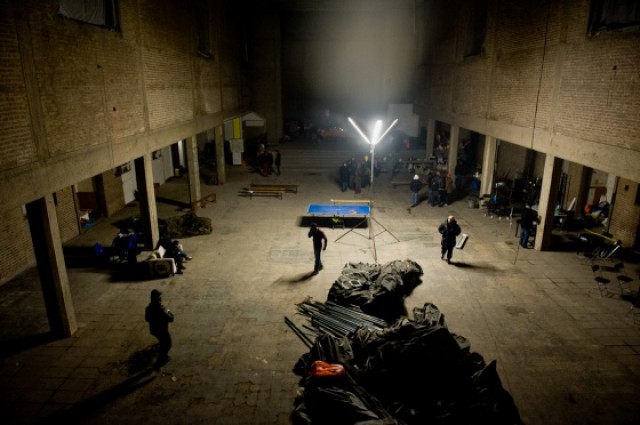
- Photo: unknown
“I’m buildin’ me a home
This earthly heart is gonna soon decay and the soul’s gotta have, oh Lord, somewhere to stay”
As I entered this building (in the preceding image), where stuff was still very much under construction, you had this big beaming, plot of light in the back, where it used to be the kitchen. But it looked so futuristic to me, that everything was dark except this one spider of light. And it reminded me of this song. And this is kind of what Ayesha Hameed is doing in her piece. She started off with a playlist, which I think is a very nice difference from using a traditional table of content, where chapter one is this, chapter two is this. She built her narrative around photographs, or different stills from movies. What I did find interesting is that she choose to describe the world of black and brown people by using only white artists. I’m not sure how that works. But I chose different artists to illustrate that. And this is the first piece.
I’m buildin’ me a home
I’m buildin’ me a home
I’m buildin’ me a home
I’m buildin’ me a home
This earthly heart
Is gonna soon decay
And my soul’s gotta have, somewhere to stay
When you hear me prayin’
I’m buildin’ me a home
When you hear me prayin’
I’m buildin’ me a home, oh Lord.
This earthly heart
Is gonna soon decay
And my soul’s gotta have, somewhere to stay …
I was reminded of this song because before they squatted the building. They had to leave a terrain where they had a little tent camp. So, in Amsterdam, in this metropolitan city, the city of tolerance and the city of — all the myths that we know about Amsterdam, you had this group of people living in tents in the middle of a rural area, where the people of the neighborhood had to look out for them because, like I said, the government kind of neglected them. And at one point, the police, as they do in Amsterdam, said, “We had enough. This doesn’t look good to the outside world, so you all have to move.” And they, instead of just breaking up the group, they said, “We are gonna stick together as a collective, and we’re just gonna see what happens.”
And they got arrested. Some of them were taken to the asylum detention centers, and some of them had the good fortune of remaining out on the street. And if you know what a detention center looks like, that is — like, that’s the better deal, to not go. To not go to prison. And then they squatted the building. I think that was the moment when a lot of people who don’t have documents in the Netherlands said, “We are not moving any longer. This is it, we are here.” And it reminded me of this song, because in the song, they sing, “I’m building me a home, this earthly heart is gonna soon decay, and the soul’s gotta have somewhere to stay.” So, for them, it was kind of the decision of saying, “we are not moving any longer. We’re here; we’re gonna have to find a way to deal with it. And we’re gonna have to find this way together.”
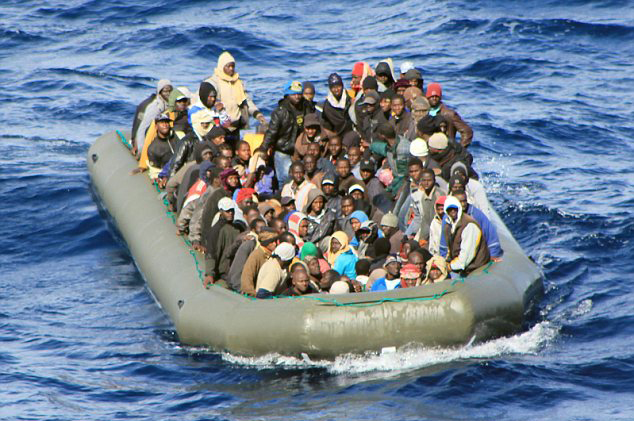
- Photo: Archive Svet24
So the theme — the two themes I was thinking about when going over literature and film and song that reminded me of this instance was also the concept of water. And water being this whole — it can either be something that’s liberating, or it can be something that’s very much overwhelming for people. It’s something that kills; it’s something that’s bigger than all of us. And I was thinking about these three songs; I’m not sure if you know them.
“São Vicente Di Longe,” Cesaria Evora
“São Vicente Di Longe” by Cesaria Evora … my Portuguese is a bit rusty. But it’s a song about people actually moving towards a place. They move towards a place, and she’s saying, “in the distance, you can see the island where we come from.” And how beautiful is it to travel toward something and overcome all the hardships, and then to arrive at the place that you consider either to be your home, or the place that you missed for such a long time, even if you don’t know what it really feels like.
“Water Get No Enemy,” Fela Kuti
The second song is from Fela Kuti. Hands? No hands for Fela? Good. “Water No Get Enemy.” And what he describes, that no matter what happens, you will always resort to water as your means for survival. So, even if your child is drowning in the water, you would still have to use it in case of a fire, if — in case you don’t wanna die. Which people often don’t want to. You still resort to water.
So, no matter how many people cross the ocean to get from the north African coast to islands like Lampedusa, which is, I think, the lowest point in Europe, people will still travel. Because there’s no hardship too big to not overcome and look for your better, safer future. Less violent future.
“Wade in the water,” spiritual
And the last song was “Wade in the Water” which is a spiritual. It’s basically a song about, if you’re running, they put the bloodhounds on you. So, the people who ran from the plantations got hunted by the dogs, and of course the dogs have some sort of super natural smell, so they can always follow you, except when you were in the water. So the water basically deletes your traces of where have you been. And I kind of was thinking about this, when people travel from the Libyan coast to Europe, the water washes out everything, who they are, concerning Europe. Because that is the moment where people say, “now, you are nothing anymore. You have documents that we see of no value. The fact that you may not have documents at all, we don’t recognize your name, we don’t recognize the fact that you don’t know how old you are. We will ask you for your area code, because we have area codes, and if you don’t know your area code, you are lying.” So basically, the ocean washes away everything that you are, so then the bloodhounds, the hunting regime that you ran from, can no longer find you. But the regime you’re running towards doesn’t recognize you anymore. So everything you are is being washed away in that passage.
And of course, there’s always room for our dearly beloved, James Baldwin. Who comes to mind when I think about how different communities treat people who don’t have documents. And I’m specifically talking about Afro-diasporic communities, black communities, who kind of leave them to their own devices. And I think it has to do with what I talked about with regards to the language, when people use language to divide communities. There’s a matter of us versus them. With regards to citizenship, you have a lot of people in the different anti-racism movements who build their narrative around the fact that, “as a Dutch citizen, you cannot treat me this way. I’m here, I was born and raised here, I pay my taxes here, so I don’t deserve your racism.” But then you are saying that somebody who doesn’t have these rights, that you are more than them.
“Some of us, White and Black, know how great a price has already been paid to bring into existence a new consciousness, a new people, an unprecedented nation. If we know, and do nothing, we are worse than the murderers hired in our name. If we know, then we must fight for your life as though it were our own, which it is, and render impassable with our bodies the corridor to the gas chamber. For, if they take you in the morning, they will be coming for us that night.”
—James Baldwin, An Open Letter to My Sister Angela Davis
So, what happens if somebody comes here and they cannot resort to Captain Passport to save them? What happens if somebody comes here and says, “well, I need healthcare because I’m a human being; not because I’m Dutch, not because I’m somebody else.” And that lack of solidarity really reminded me of his open letter to Angela Davis, which he wrote in 1970. And for me, that’s basically a sign of, “we are all next.”
You see it in the Dutch government; there’s always somebody there looking for the next victim, because policies are built around those who need protection, even though they don’t need protection. So, the image of who’s being — so, if you look at any random picture of the Dutch government, you have kind of a clue about who is being saved, who’s not being saved. Even though they talk about diversity and including everybody, the pictures are always the same. It’s predominantly white men, and for diversity, maybe a white woman. But not much more.
But the other modularized groups are lacking — for whatever reason, for maybe out of fear, maybe out of wanting to be “invisible”, speaking out for the groups that need it the most in this case, because they don’t have the basic needs to rely on.
Next text that comes to mind is from W.E.B. DuBois, from “the Souls of Black Folks”. Anybody read it? Okay, it’s — I keep seeing like a steady two hands; that’s good, that’s comforting. I like it.
“Between me and the other world, there’s an ever — there’s ever an unasked question. Unasked by some through feelings of delicacy, by others through the difficulty of rightly framing it. All, nevertheless, flood around it. They approach me in a half hesitant sort of way, eye me curiously or compassionately, and then, instead of saying directly, ‘how does it feel to be a problem?’ they say, ‘I know an excellent colored man in my town,’ or, ‘I fought at Mechanicsville, or do not these sudden outrages make your blood boil?’ At these I smile, or am interested, or reduce the boiling to a simmer, as the occasion may require. To the real question, ‘how does it feel to be a problem?’ I answer seldom a word.”
—W.E.B. Dubois, The Souls of Black Folks
And that is often a feeling I get when people talk about the asylum regime. It’s always a matter of solving either the project, the problem, or dealing with the propaganda. Or, basically seeing them as props.
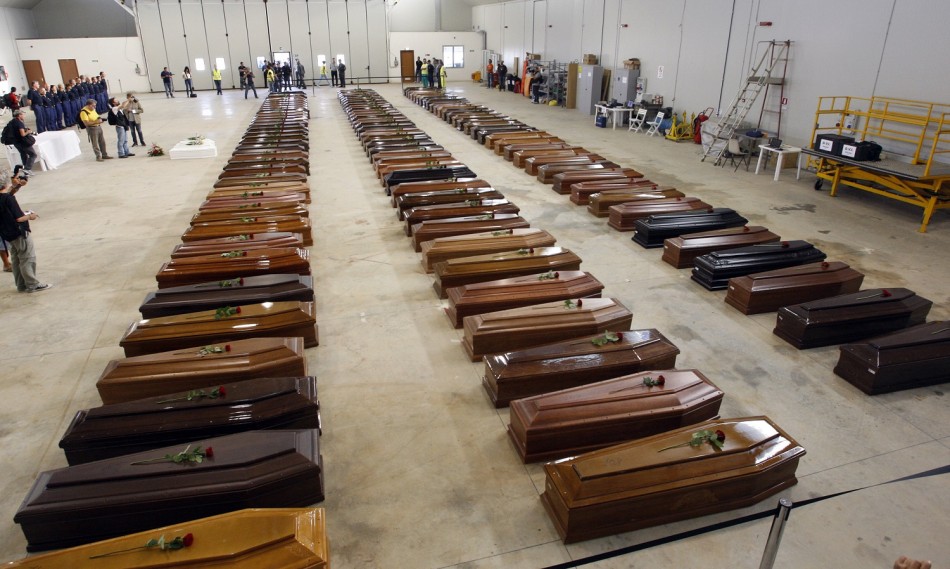
- Photo: Reuters
How does if feel to be a problem?
This image, to me, was haunting. And I try to make it my business to not produce violent imagery, but this is what happened late 2013 in Lampedusa, when one of the boats — and it’s — what makes it so difficult is that this happens all the time, when the boats collapse and the people drown. Because the boats are overfilled with people running for their homes, and then the boats — not everybody can swim, and sometimes the current is too heavy. A lot of people die while making their way here. And the policy makers talk about it as if this is a problem to deal with, and not a person you’re dealing with. So it’s never people. It’s never a person. It’s a problem, project, propaganda, or a prop. And it’s always centered at, how do we protect fort Europe from this mass invasion of The Other? Basically. There’s no reflection of how do countries have the political status they get? What happened to the country before the regime collapsed? Who funded the regime? That’s never an issue. The issue was always of, “Europe is amazing. It’s great, it has — Europe has been born amazing. So, whoever wants to come in needs to prove itself to be worth what’s happening around these parts.”
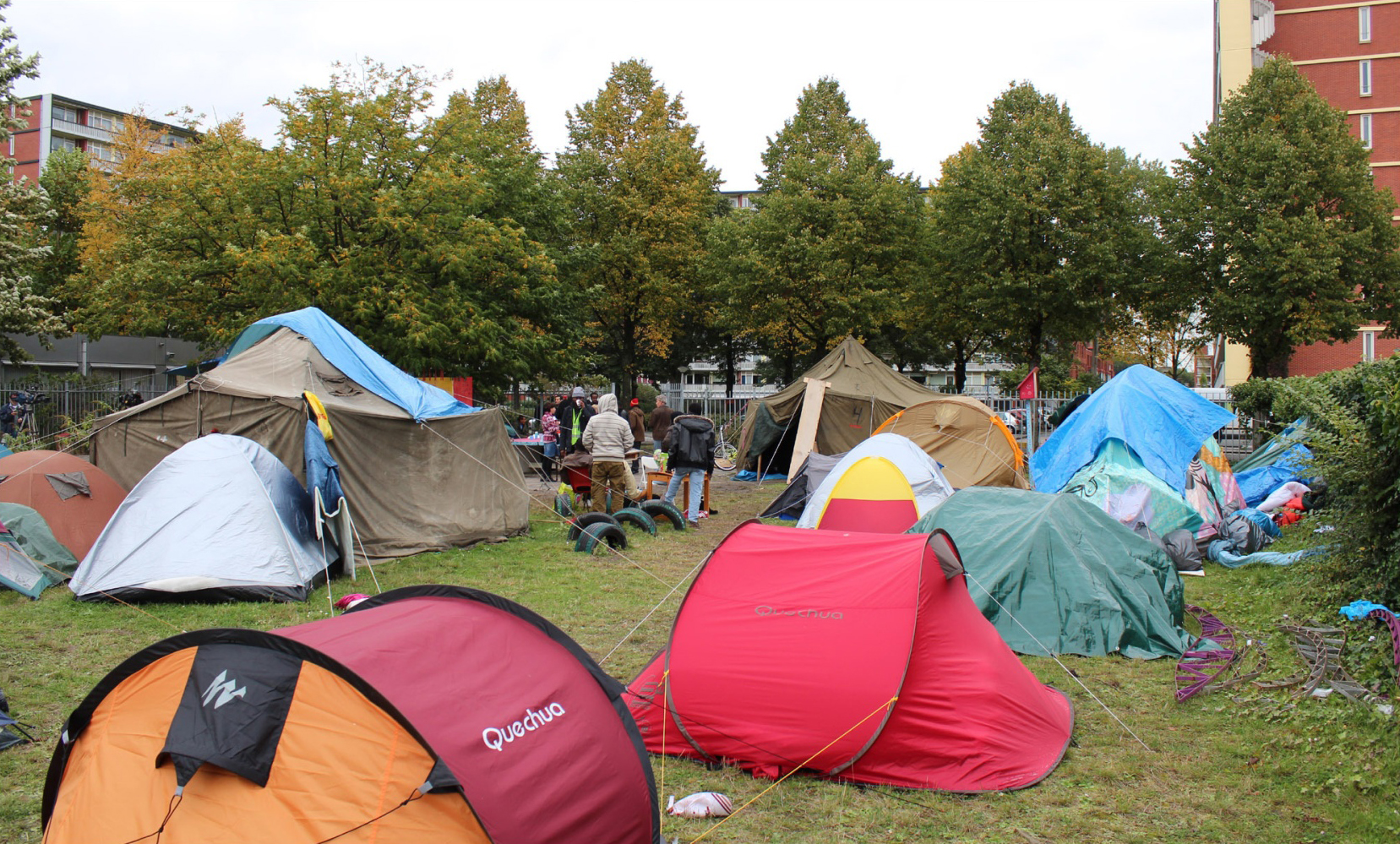
- Photo: disorde.nl
How does if feel to be a project?
Next question, as like a paraphrasing of Du Bois, like, how does it feel to be a project? When the left — which isn’t much left anymore — in the Netherlands, when they discuss people who ask for asylum, it becomes this kind of dehumanizing language. It’s treating adult people as if they are children. People talk about, “why don’t we adopt a refugee?” Like, these are adult people; like, you don’t have to adopt them to empathize with them. And you don’t have to take over their entire lives to care. You can care from where you are, and keep people going about their business; you don’t have to speak for them. But then the left jumps in, even with the tent camp, they said, “hey,” you know, “let’s help them, let’s do this.” And it becomes this colonizing of people who are — even if they don’t have what fort Europe requires — very much full-blown humans. They have — they don’t need to be taken care of in the pathologizing way people often take care for them.
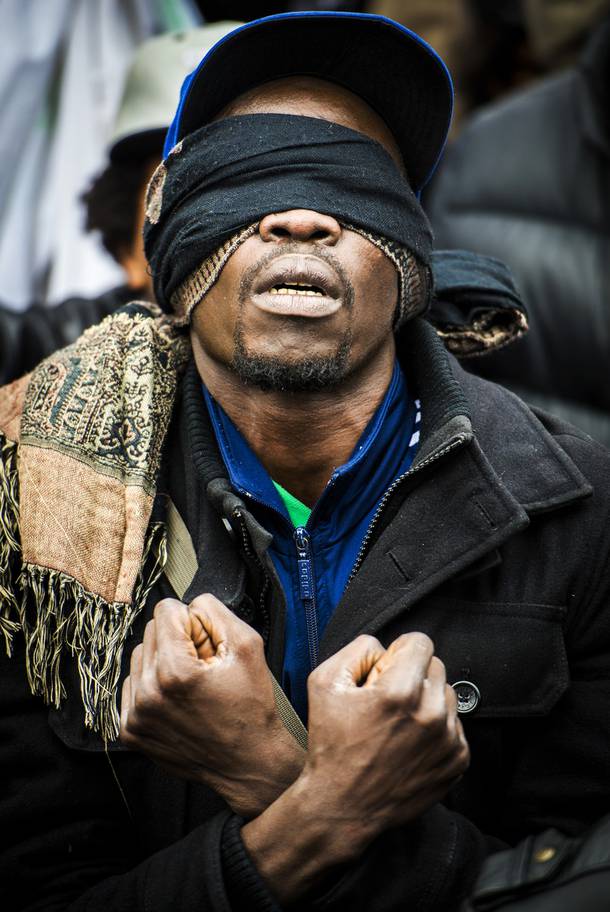
- Photo: ANP
How does if feel to be a prop?
Uh, this one was hard for me. How does it feel to be a prop? I’m not sure if anybody’s seen that film, … it’s so bad, I forgot the name. Sunny Bergman, Our Colonial Hangover? Our Colonial Hangover, or Zwart als roet, film about — her film about white privilege in the Netherlands, and about black freedom, black face. And in the film, she had a clip — and I remember this instance specifically. There was a protest again mayor van der Laan, and the whole protest was basically built around Zwarte Piet and citizenship and whites must protest. And the same day they had a hearing for the people who lived in the various squatted locations. And me and a few of my friends, we emailed organizations, said, “how can you have a protest against van der Laan, while you are excluding them from the entire narrative? And then, a lot of people, organizers, said, “you know what? Then we’re gonna include them, we’re gonna stop by, and we’re gonna build this narrative also around their stories.” And that never happened. I think one of them got to say something for a few seconds, but then it was over.
Sunny Bergman used clips of the people protesting against racism for her film. She never mentioned undocumented people. She never mentioned any of the locations. Never mentioned any of their stories. But in the film, you see a clip of this amazing brother who is called Nagi. He’s very prominently seen; he was never asked for permission to be featured in the film, but he made such a dramatic image that she could use him to get the point across. And often that is being used; you see a lot of clips or a lot of photographs documenting and archiving the heartaches of the Vluchtflat. And the people not really getting into "but what is happening?" It makes a good backdrop for a politician to stop by, hand over a check or bring some food, and you have a lot of camera people present at the moment, but when they leave, they leave. So it’s often seen as “look at how good I’m doing. Look at who also I’m caring for.” But then none of the policies really regard those people.
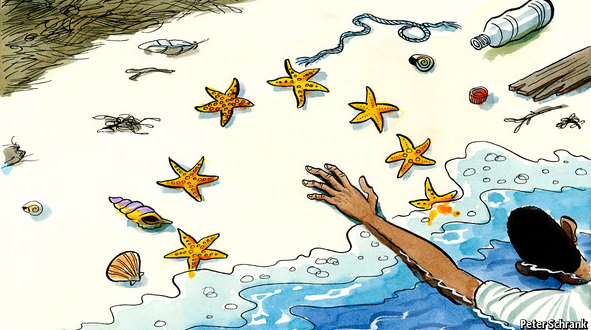
- Illustration: Peter Schrank
Propaganda benefiting from the myths of “Europe as a saint like savior who’s about to be trampled to death by millions of migrating Others.”
This is one of the cartoons I found online, which I think is troubling. Which puts Europe at the center of the dream, basically. It’s a very narcissistic idea to think that people come to Europe because Europe is so good, and not consider that they’re running from something that is so bad. I remember leaving the Vluchtkerk on one of the last days; people were packing their stuff, and one of the volunteers, a white Dutchman, said to one of my friends, “but if you could choose, what would you do?” And he was standing there with his white buddies, and he was being all — they were being all like yacht club about it, and my friend said, “if I could choose, I wanna go home. I want to go back to Sudan.” And the man’s reaction was, “but I don’t believe you! If you could really, really stay — ” For him it was unthinkable that somebody did not want to be here. And he felt insulted that the person who came here and who was being taken such good care of — at the end of the day, if his country got better, did not want to stay here.
So this whole centralizing of Europe as, “oh, this is what we would like to reach, and I come swimming with my hand in like the sea stars,” that’s ridiculous to me. But this is how it is portrayed, like Europe as this saint-like savior, who’s about to be trampled to death by millions of migrating others.
“Consider an afterlife of this gesture: the collecting of biometric information at a national or international scale. In India this is a “voluntary” system launched at a massive scale to create a national ID – for a population with a very high illiteracy rate and low income levels so that alternate forms of ID – passports or drivers licenses are not as common.
Or consider another afterlife, the Eurodac – the European database that collects the fingerprints of illegalized migrants entering the EU.”
—Dr. S. Ayesha Hameed, Skin in the Hold
So, back to Ayesha Hameed. In her text, she writes, “consider an afterlife of this gesture.” And she’s talking about — here she’s connecting futurism to the reality of today, with regards to biometrics, which I know nothing about. So, sorry to not dive into that.
I liked her idea, like I said before, of saying “illegalized” instead of “illegal”. Which brings me to the concept of invisibility.
(in)visibility: We need to analyze and de-/reconstruct the social and political myths that demand people, bodies, suffering to be/remain unseen.
I read in some other texts, when people say, “the invisible group,” like, how can we incorporate the invisible group in our policies? People are not invisible. It is a choice to not see them, and to not recognize them. But saying that they are invisible puts the responsibility on them that they haven’t done enough for you to see them. If I close my eyes here now, and I don’t see any of you, that is not your responsibility. I chose to not open my eyes and see you.
So I think we need to analyze and de- or reconstruct this social and political myth that demand people, bodies, suffering to remain or to be unseen. There is something to be wanted to not put the story of undocumented migrants out there as much. Because it’s conflicting with the idea of the Netherlands being tolerant, being open, being anything that they don’t want to be, politically and socially.
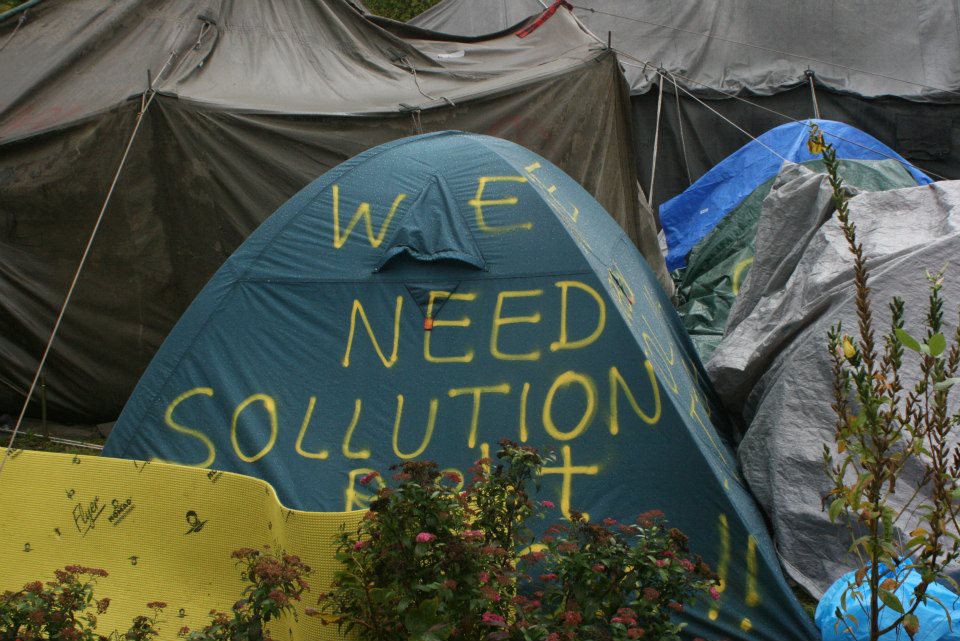
- Photo: unknown
(in)visibility: Not the responsibility of those who aren’t seen by status quo politicians, media and/or activists.
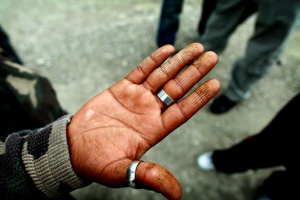
- Photo: Graeme Robertson/Guardian
Dublin Regulation: Body modification and/or mutilation as a form of political resistance.
One of the other points I found interesting in our text is body modification and/or mutilation as a form of political resistance. And for me, that was something I started to think about in Cape Town, when I saw a lot of people — I have a thing with teeth, so I’m noticing when people have something in their mouths. And a lot of people there didn’t have front teeth, and I asked one of my friends, like, “what is it?” No, first I Googled, and then I asked one of my friends what it was. And she said it is a matter of resisting. Of people knocking in their teeth to kind of give the middle finger to the regime. And it started in the 1700s, when people did it to take back control of their bodies. If you remember — or if you know, in the days of slavery, they had different ways of checking how healthy you were. Because health equaled how hard you would work on the plantation. So you would check the skin, you would check the body muscle, but you would also check somebody’s teeth, because in those days, health was connected to your teeth. So people knocking out their teeth, would have them retake the power to say, “I am useless to you. You cannot use me, because you cannot see any longer how healthy I am or not. So I’m taking myself out of your equation to be considered.”
And with regards to the modification now, I was thinking of — and I know a few people who did it, when people scrape off their fingerprints. So I don’t know if you know, if you ask for asylum, you are — basically you ask for asylum in the first country that you enter. So if you entered Europe through Italy, that’s where you have to ask for asylum. Or if you enter through France, that’s where you leave your fingerprints. If after you travel to a different country, and you end up in asylum detention, they will deport you to the country where you first asked for asylum. Because they said, “this country is now responsible for you. This is where you ‘belong’, and this is the country that now owns you.”
And I was thinking about how black and brown bodies, throughout the history, have always been the carriers of information. And the body’s either been — it’s been used to remember, or it’s been used to delete. When people were branded back in the day, no matter where you would go, the people who found you would know where you “belong”. So you have either a number on your arm, or you have a specific sign that says, “you belong to that plantation,” “you belong to that plantation.” Now you have a fingerprint saying, “you now belong — we don’t know who you are, but you belong to France. You belong to Italy.”
And I was really thinking — I liked that she pointed out, as it being something futuristic. Black bodies as the carriers of memories. And people now taking control of the memories they want deleted, or the memories they would like to save.
“The power of imagination and narrative should never be underestimated. Aside from generating innovative ideas, science fiction also triggers both a distancing and associating effect. This makes it an excellent vehicle for approaching taboo and socially-relevant yet overdone topics in new ways.”
—Nnedi Okorafor, African Science Fiction is Still Alien
I think everybody who has been in the Netherlands long enough knows that there is no direct way of discussing anything. Like, you have to really work around the bush, because nobody wants to feel offended, nobody wants to feel not good. And I think Afrofuturism is really an idea of discussing what would happen if people move in a specific way. Like I said, I’m not — I wasn’t grown on futurism, so bear with me. Was it X-Men that was used to tell the story of the civil rights movement?
I think it’s a good tool to discuss topics that are harder for people to talk about. Because now it becomes this sort of fictionalized object that we can talk about in theory, while we all know what’s happening. But it’s specifically Dutch to not really — to not really name it. And then, it reminded me — or, at least, I connected it because I learned about this artist a few days ago. Mary Sibande, who has this piece called Purple things shall govern.
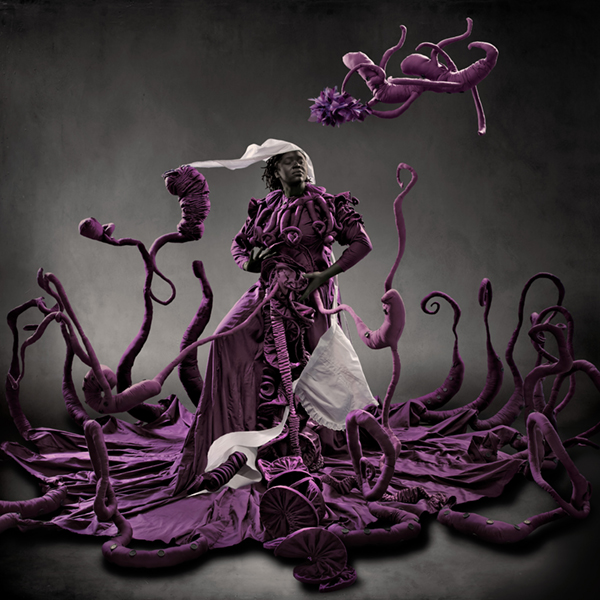
- Photo: Jurie Potgieter/Gallery MOMO
—Futurism: Purple things shall govern —Mary Sibande
And again, with regards to black bodies carrying information, this was a piece that’s modeled after the protest in 1989, where people were protesting against the segregated government in South Africa. And at the moment of the protest, the police came up with this bright idea to put the water cannon on the people, but there were so many protestors that they put purple paint inside the water tank. So everybody who got sprayed with water had this purplish stain on their skin, so even days after the march, people could still arrest you because you looked purple.
And again, it’s this idea of, “we can do to black bodies whatever we want, as long as we remember what we need to remember about who they are and how they travel.” Which reminded me of having like fingerprints, - so people from South Africa, with regards to the tainted skin, it becomes a means to identify, and to remember, and the fact that you might not be able to paint somebody purple doesn’t occur to people. Because your body is used for us as a tool of information.
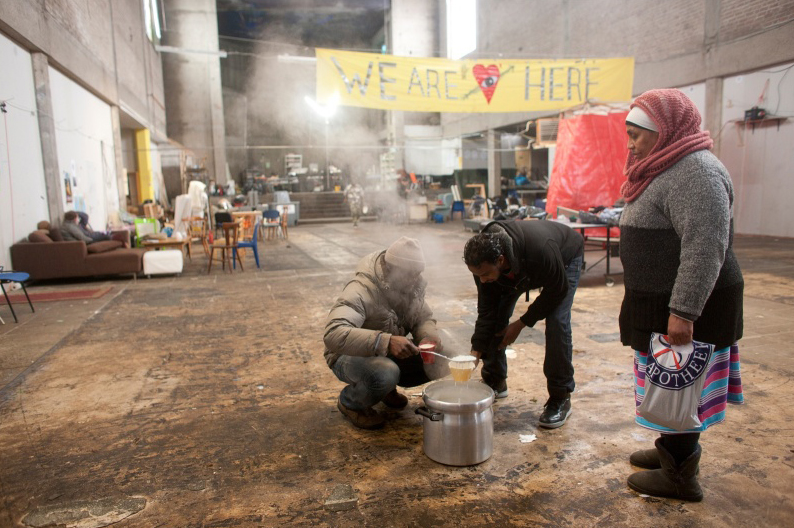
- Photo: Boudewijn Bollmann
—Futurism: history, healing, imagination, justice
It reminded me of this picture, which is one of the earlier days in the Vluchtkerk, one of the locations. The two men that are squatted, you cannot really see their faces, on the ground, they were cooking something before there was a kitchen. They always had a very clear goal of what they wanted to accomplish with the stories of the people who were forced to migrate here. And one of them — the brother in the middle, with the black jacket — had a TEDx talk, I think maybe a year and a half ago, and for him, this was really this ground-breaking moment of being in charge of the story he wanted to tell. And a lot of people said, “oh, we can help you with the text,” or, “let’s write it together.” But he made it very clear, he said, “I want to write the text myself. This is my moment to tell my story.” And I think when he first got here, already he says, “I never imagined being able to speak in a room full of politicians. I never imagined being able to speak in the hall with the mayor, but I did it.” And I think futurism can also be less abstract, so you don’t always have to have this bleeping space cadet. But you can also imagine a future where you take control of who you are, and where you re-imagine a more pleasant place for yourself.
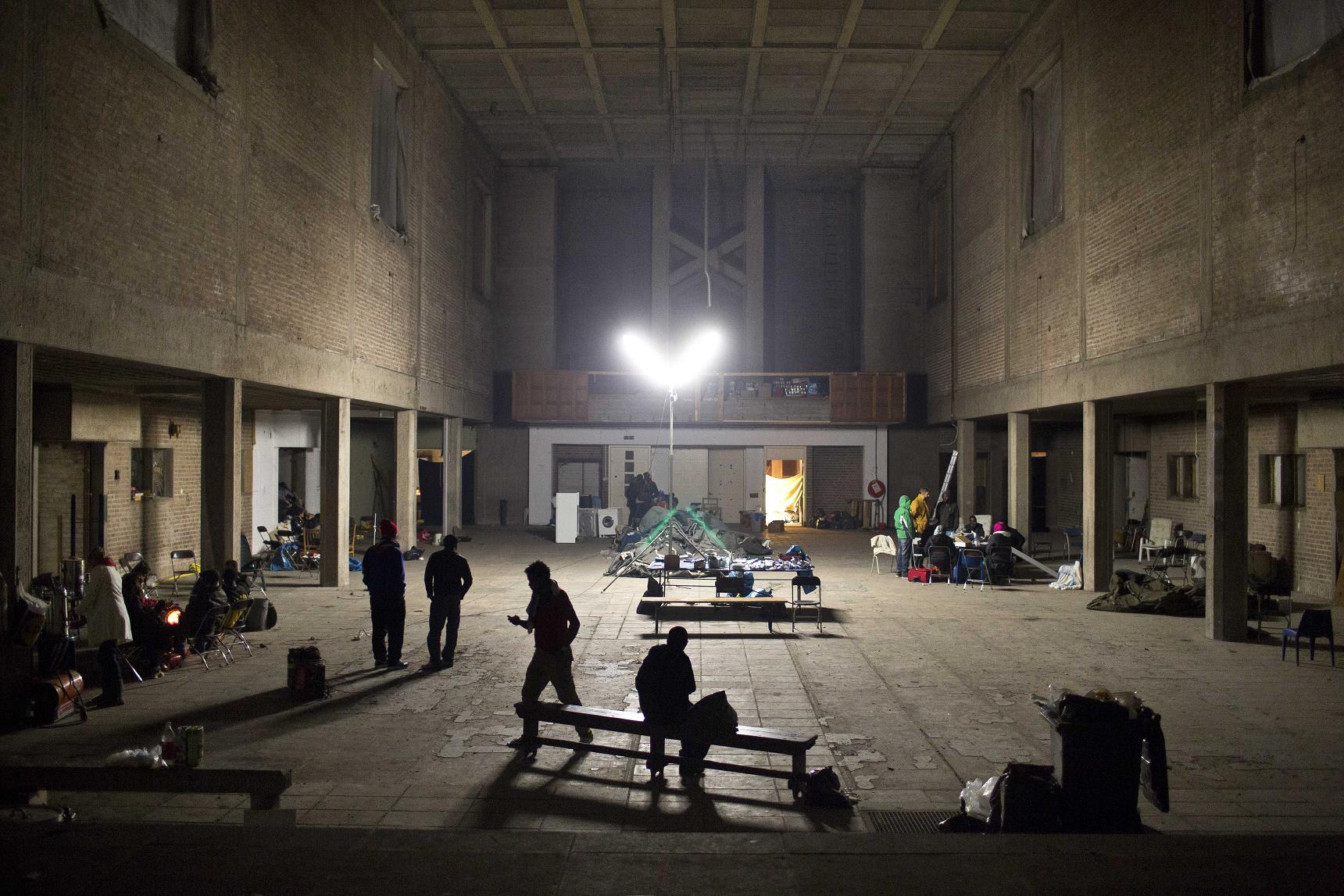
- Photo: Roeland Koning
—Futurism: “We are in need of some radical imagination” —dream hampton
I was reading a quote by dream hampton, who I think is a nice writer. She said, “we are in need of some radical imagination.” I’m not sure if anybody who walked into the empty church at that specific windy afternoon imagined the political shift that they would create. We are now many months, many years down the road, and you have buildings like Vuchtgebouw and Vluchtgarage. I think most people know them by now. Most people in Amsterdam, at least, know them by now. I don’t think anybody who walked inside this empty, decaying church imagined that they would have any sort of influence on the policies that are being made today.
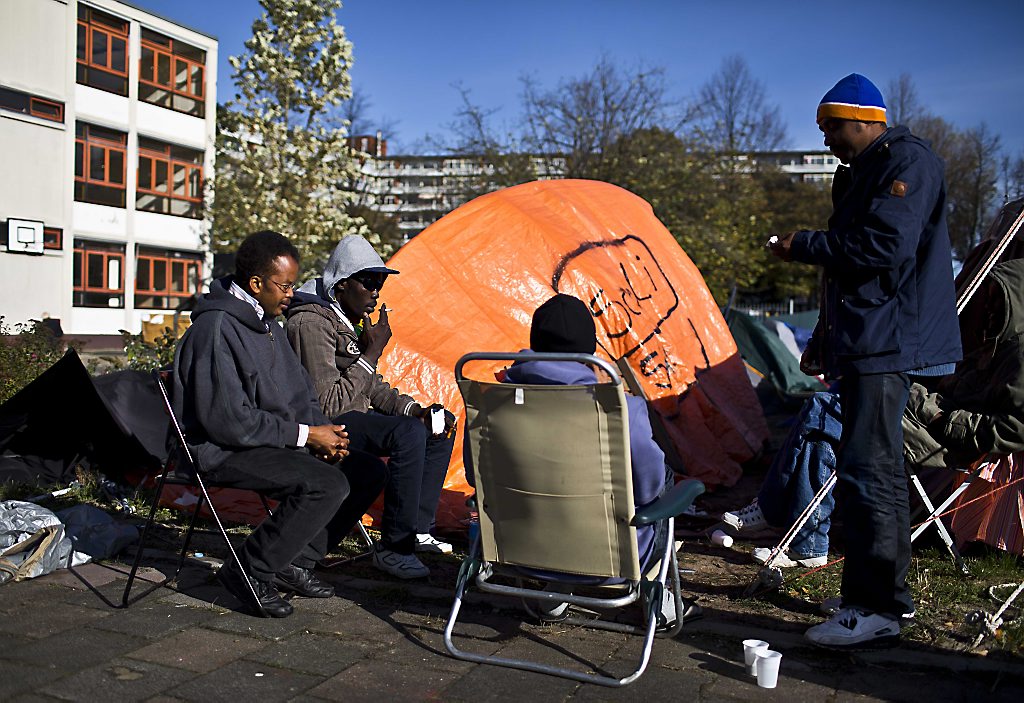
- Photo: ANP, Ilvy Njiokiktjien
—Futurism: Survival as a post-apocalyptic era on an individual, as well as, a collective level
What I described as my fear, with regards to science fiction, was this earth where nothing else exists. So, you are the last survivor, you land somewhere, and nothing is your own anymore. Like, you have to re-discover everything where you’re walking, where you’re going. Everything is empty to you, because you have no access. Like, I think you have the movie 28 Days Later, when somebody wakes up and the whole town is just vanished. And even though everybody is here because they all had — they all described that sense of loneliness. Loneliness in a room where there are a lot of people. I don’t think the presence of bodies makes you more — makes you feel less lonely. You can still — it can still be apocalyptic even though we have a different experience. If you roam the streets, you have no money, you have nowhere to go, you have no care. It might as well have been a deserted city, a deserted street to you.
—Futurism: Speeding up the process of reimagining past, present and future icons of freedom and liberation
This came to me — the sign, COA is like the organization that is in charge of housing people who are still in a procedure, or have reopened their procedure. So if you come here and they think you have a chance of getting your residence permit, they put you in COA. Like an asylum center. And as I visit the other day, I flipped over my visitor’s pass, and you had this logo — I’ve never really looked at the logo before, but the back of the card describes what the logo is, and it’s an old Greek story, about a man who fled burning Troy with his father and his kid, and he had like all these trials and tribulations, he’s been to jail, and then he settles in Italy and he founds the city Latium. And he’s been considered this big hero with regards to migration.

- Photo: Joost van den Broek
I was like, “isn’t that kind of interesting?” Because COA is really designed to basically send people back to where they came from. They make it super hard for you to get your papers. They will do anything for you to not stay in the Netherlands, yet their logo is based on somebody who did the exact same thing as people are doing today, yet he is considered a hero. So, all things European are kind of cool, kind of hero-esque, but when the same person comes from Sudan, from Eritrea, Somalia, Chad, Niger, they become a burden to society. They become a problem, they become a project. They don’t become the hero on the back of a visitor’s pass. And I think we should really think about who we consider to be our heroes and our icons when we think about — when we re-imagine freedom and liberation.
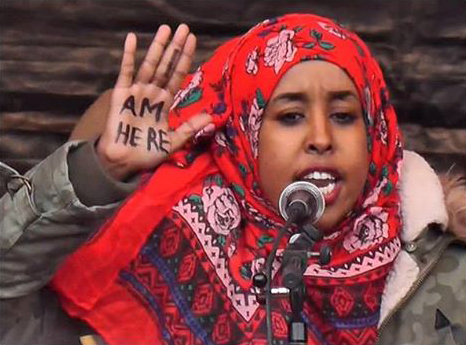
- Photo: unknown


